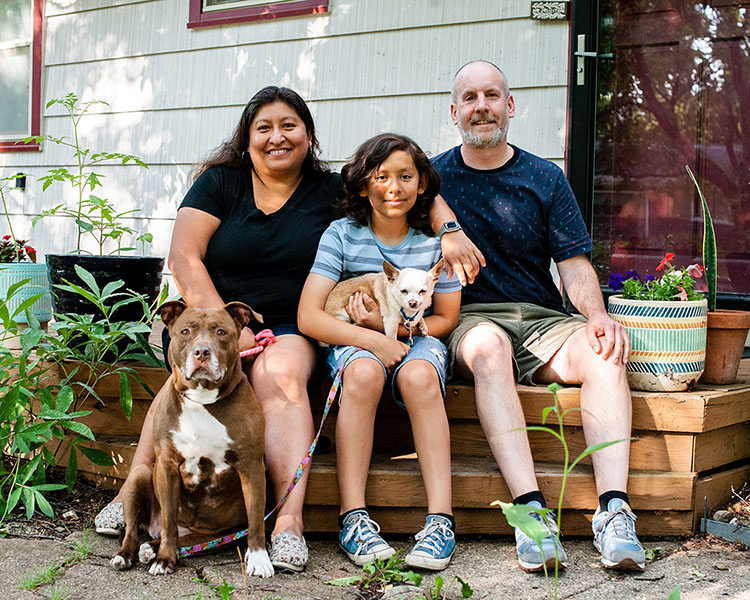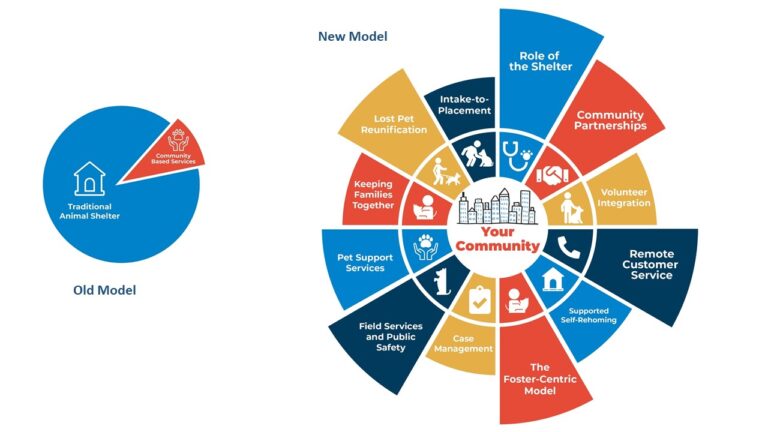Answer: An outdated animal care system puts everyone at risk. Your shelter wants to work with you to change that.

Get Started Now
Here are the top five actions you can take for people and pets in your community. Share these with at least three other leaders.
1. Reassess reclaim/redemption fees and policies
Nationally, 54% of dogs enter as “strays” and fewer than half will be reunited with their families. Historically, municipalities and animal shelters have leaned on steep reclaim fees to discourage community members from allowing their dogs to roam, but a punitive-first system creates barriers between pet owners in need and the animal care organizations that could help them. Fines and fees don’t change an animal’s behavior or fix a broken fence, but they can mean the difference between a pet going home and a pet staying in the shelter, ultimately increasing cost of in-shelter care and contributing to overcrowding, putting the overall shelter population at risk. As adoptions fail to keep pace with dogs entering shelters, length of stay increases and the fiscal impact on the shelter grows each day. Consider conducting a fee analysis to determine what your community members can realistically afford to pay. If your county or municipal code doesn’t allow shelters to lower or waive fees when necessary to get pets home, work with your local shelters and community to change it.
2. Allocate funding to community-wide spay/neuter efforts
It’s especially critical to encourage support for initiatives that build veterinary capacity and expand access to spay/neuter: Among the many benefits, sterilization encourages pets to stick close to home, increasing their safety and decreasing the number of dogs and cats roaming the streets. But when spay/neuter surgery had to be suspended during the pandemic, we fell nearly three million surgeries behind what would normally have been accomplished. A nationwide shortage of veterinarians and veterinary nurses is making it even harder to keep up with the need, let alone catch up from the deficit, which is compounded in communities that already lacked affordable veterinary care or veterinarians at all
It’s more important than ever to ensure all community residents and TNR groups have access to spay/neuter for animals. Community leaders are working together to make it happen. For example, thanks to Rancho Cordova’s Community Enhancement Fund, the Rancho Cordova City Council partners with Rancho Cordova Animal Services, the County of Sacramento, and organizations like Whisker Warriors to provide residents with free or low-cost spay/neuter, free pet licensing, TNR for community cats, and pet food supplies.
3. Support or introduce co-housing initiatives
Too often Californians experiencing homelessness or domestic violence cannot access temporary or emergency housing because doing so would mean leaving their beloved animal companions behind. 34.9% of California women and 31.1% of men have experienced intimate partner physical violence, sexual violence and/or stalking in their lifetimes. According to the National Alliance to End Homelessness 2023 report, Californians have the highest likelihood of being unhoused, 44 out of every 10,000 residents, with over 170,000 individuals experiencing homelessness in the state. Co-sheltering—as defined by My Dog Is My Home as the sheltering of people and animals together at the same emergency or temporary housing facility—allows people and pets to stay together as they seek safe shelter. Animal care organizations and human social services organizations are working together to bring co-sheltering to their communities. Learn more about co-sheltering and join the Co-Sheltering Collaborative at https://www.mydogismyhome.org/.
4. Advance affordable, pet-inclusive housing efforts
In California, 35 million pets reside in over half of households, and housing or landlord issues are among the most commonly cited reasons for pet surrenders. As towns and cities work together to confront the statewide housing crisis, we must ensure safe, affordable housing is accessible to all pet owners. Though protections now apply to Californians residing in housing financed by the California Department of Housing and Community Development, many more California renters, if they can find pet-inclusive housing, face breed or weight restrictions or non-refundable pet deposits or monthly pet rent.
For more data and market-based solutions that could ensure access to safe, affordable housing for people and pets in your community, visit the Pet Inclusive Housing Initiative. To get an idea of how your region is doing on creating inclusive pet policies, visit the National Rental Research Dashboard.
5. Support animals and people who care for them through a holistic approach
Animal shelters, veterinarians, and human health and social services providers recognize that the health and well-being of humans and animals are intertwined: people who face systemic barriers and structural discrimination also experience a lack of access to resources, services, and opportunities for caring for their pets. A holistic One Health/One Welfare approach acknowledges the connection between the health of animals, people, plants, and the environment, and allocates funding and shapes policy and services accordingly.
Support animal shelters’ and animal services agencies’ move from a surrender-first model to a prevention-based, support-first model that focuses on keeping animals in their homes. To learn more about the impact of human-animal relationships on overall community well-being and read California for All Animals’ strategic recommendations for addressing urgent issues facing animal shelters, visit the following resources:
- California for All Animals Legislative Report 2023
- Helping People and Animals Together Report (Vancouver Humane Society)
- Companions and Animals for Reform and Equity (CARE)
The Real Problem
The majority of animals in shelters don’t need new homes.
Over half of animals in shelters nationwide already have dedicated caregivers, but their families face financial, language, transportation and other barriers to bringing them home. For Black, Indigenous, and people of color, as well as families with lower incomes, barriers are compounded. These obstacles contribute to an alarming reality: Fewer than 1 in 20 cats and 5 in 10 dogs ever make it back to their families.
Many other animals in shelters were surrendered by owners who, with proactive support for housing, food, vet care and other community-wide challenges, would have been able to keep their pets. Lack of access to affordable housing along with rising costs of necessities like food, transportation and healthcare for both people and pets also affects people’s ability to adopt pets who do need homes.
The other crucial stats: Most people are trained to look at euthanasia rates as a measure of success, but we should also be looking at the rate at which pets are reclaimed from shelters by their owners (also called RTO or Return-to-Owner rates), as well as services offered that keep animals in homes.
Powerful Solutions
Shelters are leading the way toward holistic solutions, and they need your support.
Shelter teams across California see firsthand how animal health is tied to human and community health. That’s why they’re working so hard to transform sheltering from a punitive-centered, surrender-first model to a prevention-based, support-first ecosystem that focuses on keeping animals in their homes.

Together we can dismantle barriers and build a more equitable system to end the cycle of unnecessary pet impoundment and euthanasia that harms animals as well as the people who care for them outside shelter walls and within. This cycle is accelerated by attempts to make a shelter revenue-generating, which costs animals, people, and communities more in the long run. One powerful step you can take to remove barriers is to join shelters and other city leaders who are reassessing reclaim fees that stand between pets and people.
Better for budgets, animals and community members
Advancing practices and policies that remove barriers and help keep animals in their homes supports the well-being of pets and people in your community, fights shelter crowding and euthanasia, and reduces the costs of in-shelter care.
When people have access to essential supports and face fewer barriers to reclaim their pet from a shelter, more animals can stay in their homes.
More shelter resources and homes for animals who truly need them.
Less crowding = lower disease rates and cost of care. Improved animal wellness = happier staff and greater retention.
More pets safe at home.
Better overall health and well-being and safer, stronger communities.
Key Resources
- Grants for your California shelter – California for All Animals funding made possible through a partnership between Gavin Newsom’s Animal Shelter Assistance Program (ASAP) and the UC Davis Koret Shelter Medicine Program
- UC Davis Koret Shelter Medicine Program facility consultations for shelters
- California for All Animals 2023 Legislative Report
- Helping People and Animals Together Report (Vancouver Humane Society)
- Access to Care survey – Statewide survey reveals the debilitating impact of the nationwide veterinarian and veterinary care shortage in California
- Guidelines for Standards of Care in Animal Shelters
Further Reading
- Pet Rent Is the Newest Tool of Housing Discrimination – On the near impossibility of finding affordable, pet-inclusive housing in California
- “Whose life do we save?” – This 3-minute listen highlights the difficult decisions your community members are grappling with
What are shelter reclaim fees (also called return to owner or redemption fees)?
When a pet found outside is presumed lost and brought to the shelter by animal services officers or community members, owners will likely have to pay redemption and/or boarding fees and potentially civil fines in order to reclaim their pet. These fees are often set at a municipal or county level with no discretion given to shelters to waive or lower them.You can help make sure fees don’t stand between pets and people who love them by joining with your shelter to advocate for their ability to lower or waive fees in order to reunite pets with their families.

